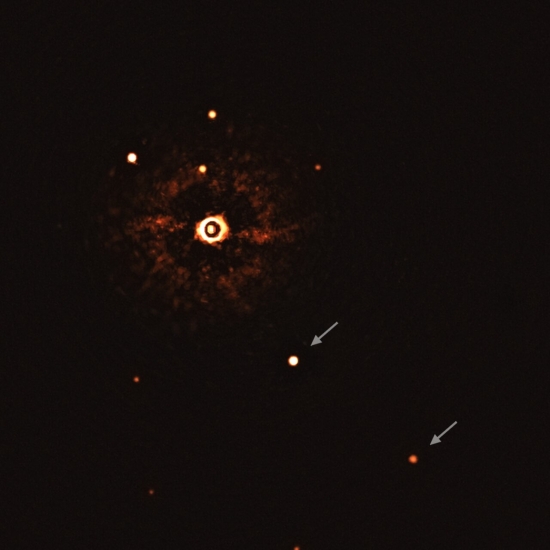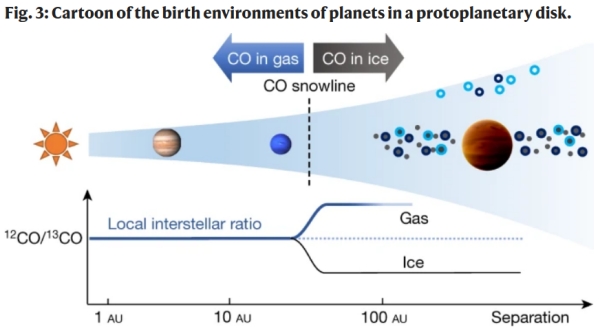300 light years from Earth in the constellation Musca, the gas giant TYC 8998-760-1 b, along with a companion planet, orbits an infant K-class star about 17 million years old. We’re probably looking at a brown dwarf here rather than a gas giant like Jupiter, for TYC 8998-760-1 b is about 14 times Jupiter’s mass, nudging into brown dwarf territory, and it appears to be roughly three times as large, unusual for brown dwarfs. The planet’s separation from its host star is pegged at 160 AU.
An inflated atmosphere due to processes still unknown? We don’t know, but both this and the companion planet have been directly imaged. Now TYC 8998-760-1 b resurfaces through work with the European Southern Observatory’s Very Large Telescope, as reported in the latest issue of Nature. Led by first author Yapeng Zhang (Leiden University, The Netherlands), the team of astronomers detected carbon isotopes in the object’s atmosphere, showing higher than expected carbon-13 content.
Here is the image, first released in 2020, of the TYC 8998-760-1 system, showing the two young planets. One of the co-authors of the Zhang paper, Alexander Bohn (also at Leiden), worked on the earlier imaging as well. The caption is the original one from ESO accompanying the image and does not describe the later work by Zhang’s team.

Image: This image, captured by the SPHERE instrument on ESO’s Very Large Telescope, shows the star TYC 8998-760-1 accompanied by two giant exoplanets, TYC 8998-760-1b and TYC 8998-760-1c. The two planets are visible as two bright dots in the centre (TYC 8998-760-1b) and bottom right (TYC 8998-760-1c) of the frame, noted by arrows. Other bright dots, which are background stars, are visible in the image as well. By taking different images at different times, the team were able to distinguish the planets from the background stars. The image was captured by blocking the light from the young, Sun-like star (top-left of centre) using a coronagraph, which allows for the fainter planets to be detected. The bright and dark rings we see on the star’s image are optical artefacts. Credit: ESO/Bohn et al.
Different forms of the same atom, isotopes vary in the number of neutrons housed in the nucleus, so that while carbon-12 has six neutrons to go along with its six protons, carbon-13 has seven neutrons and carbon-14 has eight. The distinctions are useful because while chemical properties remain largely the same, isotopes can be distinguished as they react to different conditions and are formed in different ways.
Zhang’s team drew on the distinction between carbon-13 and carbon-12 as marked by the way each absorbs radiation at slightly different colors, using ESO’s Spectrograph for Integral Field Observations in the Near Infrared (SINFONI), mounted on the Unit 3 instrument of the VLT. Expecting about one in 70 carbon atoms to be carbon-13, they found twice the number. The planet’s formation seems to be implicated, according to co-author Paul Mollière (Max Planck Institute for Astronomy, Heidelberg):
“The planet is more than one hundred and fifty times further away from its parent star than our Earth is from our Sun. At such a great distance, ices have possibly formed with more carbon-13, causing the higher fraction of this isotope in the planet’s atmosphere today.”

Image: This is Figure 3 from the paper. Caption: The two planets inside the CO snowline denote Jupiter and Neptune at their current locations, whereas TYC 8998 b is formed far outside this regime, where most carbon is expected to have been locked up in CO ice and formed the main reservoir of carbon in the planet. We postulate that this far outside the CO snowline, the ice was 13CO-rich or 13C-rich through carbon fractionation, resulting in the observed 13CO-rich atmosphere of the planet. A similar mechanism has been invoked to explain the trend in D/H within the Solar System. Future isotopologue measurements in exoplanet atmospheres can provide unique constraints on where, when and how planets are formed. Credit: Zhang et al.
The study of isotope abundance ratios has proven significant in studying not only interstellar chemistry and star formation but also the evolution of the Solar System. While its uses in analyzing exoplanet atmospheres are in their infancy, the hope is that future work on a range of exoplanets will offer clues to their formation.
The paper is Zhang et al., “The 13CO-rich atmosphere of a young accreting super-Jupiter,” Nature 595 (14 July 2021), 370-372. Abstract.



One would think that if a planet forms at sufficient distance that the bulk of the solid carbon is the low boiling point point CO molecule in which fractionation enriches the C13 content, that comets might also be considerably enriched in such a molecule and in C13.
While there is some small evidence this is the case (and here), it is nowhere near as enriched as the planet in the paper. If the long-period comets formed in the Oort cloud, they should have the enriched C13 in their CO component, but this does not seem to be the case. Is this indicating a discrepancy in the model, or in the formation or solar system comets?
Comets tend to have elliptical orbits so could have enriched C13 core areas and C14 coverings as they move through the phase change regions.
I appreciate that comets are not pristine by the time we see them, and we don’t know how many previous passes they have made. Unfortunately, we cannot reach the Oort cloud to sample bodies out there (assuming they exist). We need a sample from inside a comet as you suggest or an analysis of a body that may be pristine like 2I/Borisov.
A remarkable image of the sort we would like to see someday of closer
stars with terrestrial planets. I suspect that the disk-like images of the planets and the star itself are the stretched Airy disk images of point sources of light, differentiated to the resolving limit of the optics. Going even farther, I’d guess that the images of the planets are much akin to the effect observed with the star, save for the corona-graph making the star less intense but bright enough to display the annular feature of the Airy disk.
While carbon isotope measurement is a significant enough detection, there should be a story as well for single proton hydrogen and deuterium. A very young low end brown dwarf could also be engaged in deuterium fusion. And there should be some interesting issues surrounding that activity. For one, the deuterium burning phase in brown dwarfs does not last long as compared to stellar hydrogen fusion.
And for another, I am still unaware of a breakdown by mass for how long the process should go on. In an early study, the figure of 300,000 years sticks with me. But then you have a range of brown dwarf masses from 13 to 80 Jupiters. A low end, if like stellar, would tend to stretch the period, right? But how long? Which brings us to the apparently large diameter for the object in question. Assuming it was in the midst or near the end of the big burn, perhaps it would retain a significant amount of heat in the outer layers. Though the abstract and this synopsis does not tell us much about the other jovian exoplanet. Depending on its nature, it could throw a wrench into this picture I’ve just painted – or substantiate it. There is also the question of which band we are viewing this object in: infra red, visible or what?
Hi Paul and readers
Yes an interesting system, and Brown dwarf too.
“An inflated atmosphere due to processes still unknown? We don’t know’
At 14million years old this brown dwarf would be extremely hot giving it an inflated atmosphere as it ages and cools expect it to shrink rapidly in size. It could also still be process of forming too and growing.
Cheers Edwin
They have very powerful gravities and should be smaller even if hot, perhaps a disc on accretion disc.
I would think that a lot depends on the original cloud that formed this system was made from. If a nearby supernova was the source, the isotopes abundances would be affected and the higher levels of radioactive isotopes could also explain the brown dwarfs inflated atmosphere.
Wont the star be enriched too if it had happened in the nebula?
Good point, but the question is after 17 million years where are those isotopes at in the star? The core or outer convection layers of the K3IV star? Which by the way is a subgiant classification and has a mass of 1 solar mass.
Here is a good clue and looks like a supernova neighborhood of OB stars!
The star formation history and accretion-disc fraction among the K-type members of the Scorpius-Centaurus OB association.
http://simbad.u-strasbg.fr/simbad/sim-ref?bibcode=2016MNRAS.461..794P
This is the reference from simbad for the star type of TYC 8998-760-1, so in a area chocked full of supernova remnants and possible neutron star and black hole mergers. Maybe even white dwarf formation of C13 enrichment:
Extreme 13C,15N and 17O isotopic enrichment in the young planetary nebula K4-47.
https://www.nature.com/articles/s41586-018-0763-1?WT.feed_name=subjects_physical-sciences
The unusual molecular and isotopic content of planetary nebulae.
“Observations of planetary nebulae have revealed unusual molecular content and surprising enrichments of rare isotopes, challenging both chemical models as well as our current understanding of stellar nucleosynthesis.”
https://phys.org/news/2020-06-unusual-molecular-isotopic-content-planetary.html
https://www.universoastronomia.com/wp-content/uploads/2018/12/m2d9_hubble_960.jpg
M.F.,
That helps. Thanks.
Locally, here on Earth(?), C13 is about 1 percent of the carbon and it is considered a stable isotope. This would raise a question of how much
C13 ( percentage wise) might induce a C13 shadow on a carbon spectrum.
The kinetics of escape, for example, would be a lot more pronounced with hydrogen and deuterium.
Trying to get more background on C12 and C13 ratios. Though this is distinct from brown dwarfs and Jovian planets came across something for later reference if discussion leads to terrestrial planets: I note that
the Permian extinction was related to a burst of C13 in fossil remains.
This was attributed to an increase in atmospheric CO2 by an order of magnitude
“Six-fold increase of atmospheric pCO2 during the
Permian–Triassic mass extinction”
https://www.nature.com/articles/s41467-021-22298-7
Noting the Permian as an extinction and the C13 signature related to it, had to wonder if it were related to a nearby supernova or other explosive event. The paper at the site does not make this connection directly, but describes geological events in continental masses of that epoch. In any case, this convinces me that C13 will come up again in other exoplanet guises.